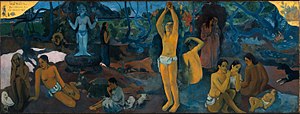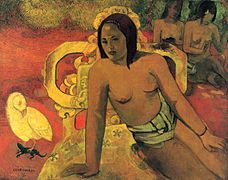Where do we come from? Who are we? Where are we going?

|
| Where do we come from? Who are we? Where are we going? |
|---|
| Paul Gauguin , 1897-98 |
| Oil on canvas |
| 139.1 x 374.6 cm |
| Museum of Fine Arts, Boston |
Where do we come from? Who are we? Where are we going? is a painting by the French painter Paul Gauguin . It is considered his most famous work of art and was regarded by him as his main and masterpiece and the culmination of his creative work. With dimensions of almost four meters in length and over a meter in height, it is also the largest painting by Gauguin.
History of origin
Gauguin noted Where are we from? Who are we? Where are we going? finished within four weeks at the end of 1897 in his self-built hut in Tahiti . The painting has a testamentary character: Gauguin itself claims to have created it with the intention of then suicide to commit. The reasons included the news of the death of his daughter Aline, his health deteriorating further from syphilis and a heart attack, as well as persistent and increasingly pressing financial difficulties. However, the attempt to poison with arsenic failed.
The title and the allegorical representation of the painting take up man's primal questions about the meaning and goal of life, which Gauguin was very concerned about despite his anti-clerical attitude. He had previously worked on religious and mystical topics from theosophical to esoteric in works such as The Vision after the Sermon (1888) and The Spirit of the Dead Wakes (1892).
Description and interpretation
According to the artist's wish, the picture is to be viewed from right to left. In the upper left corner is the inscription D'où Venons Nous / Que Sommes Nous / Où Allons Nous without the question marks usually used to denote the painting. Gauguin himself stated that the inscription should be understood less as a title than as a signature. On the right the artist signed P. Gauguin / 1897 .
Depicted are de-individualized, original people in three different phases of the life cycle : from birth in the form of a sleeping baby to death contemplated by an old woman. The majority of the people depicted are painted in bright orange that contrasts with the bluish-green background.
In the center and oversized in the middle of the painting stands a figure in the prime of its years, reaching for a ripe fruit of paradise with natural ease. The composition of the harvesting man and three other people around him corresponds entirely to that of the picture Tahitian Man with Raised Arms (1897) from the same year . Numerous other self-quotations are characteristic of the painting: the figure in a melancholy, resigned posture can already be found in the portrait of Breton Eva (1889), the person next to her evokes the pose of the female model by Vairumati (1897).
Vairumati , 1897
To the right of the picture is a black dog, through which Gauguin often depicted himself in his paintings. According to Gauguin, the white bird on the far left of the old woman stands for the “nothingness of empty words” (“l'inutilité des vaines paroles”) and is therefore to be understood as a vanitas symbol. He takes up a motif that he had already used in his work Vairumati and was to use again in his allegorical late work Adam and Eve (1903). He described the blue statue in the background as symbolizing the afterlife.
Reception and provenance
Where do we come from? Who are we? Where are we going? Today is one of the most famous paintings by Paul Gauguin and is one of the most important works of symbolism . Shortly after it was completed in 1898, he sent it to his artist friend and art collector George-Daniel de Monfreid , who handed it over to Ambroise Vollard . The painting was first publicly exhibited in his gallery between November 17 and December 10, 1898. It then went through the hands of numerous other European and American art dealers. Since 1936 the work has been owned by the Museum of Fine Arts in Boston . In 2007 it was shown on the occasion of the exhibition Cézanne to Picasso at the Art Institute of Chicago , and in 2013 as part of the exhibition Gauguin and After: Voyage into the Myth at the Seoul Museum of Art in South Korea .
Web links
- Information about the painting on the website of the Museum of Fine Arts in Boston , accessed November 20, 2013.
Individual evidence
- ↑ Maurice Malingue (ed.), Lettres de Gauguin à sa femme et ses amis , Paris: Grasset, 1949, p. 289.
- ↑ Naomi Margolis Maurer: The Pursuit of Spiritual Wisdom. The Thought and Art of Vincent Van Gogh and Paul Gauguin , Cranbury (NJ): Associated University Press, 1998, p. 168.
- ↑ Gauguin described his intentions and his working method in great detail in a letter to George-Daniel de Monfreid dated February 1898; Victor Segalen (ed.), Lettres de Paul Gauguin à George-Daniel de Monfreid , Paris: Georges Crès, 1918, pp. 201–202.
- ^ "Cézanne to Picasso" , exhibition at the Art Institute of Chicago , accessed on November 20, 2013.
- ↑ Gauguin and After: Voyage into the Myth ( Memento of the original from June 10, 2015 in the Internet Archive ) Info: The archive link was inserted automatically and has not yet been checked. Please check the original and archive link according to the instructions and then remove this notice. , Exhibition at the Seoul Museum of Art, accessed November 20, 2013.




